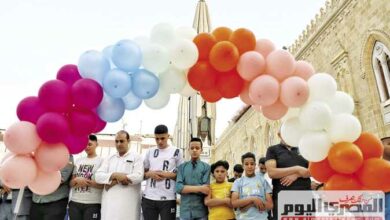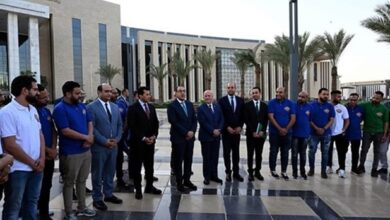A holiday treat with an ancient pedigree
I thought a lot before writing this article for fear it might encourage the muftis to impose a ban on Eid kahk, our seasonal Ramadan biscuits. Suspecting a crusader-inspired heresy, they might be tempted to rule it haram (forbidden).
Even if they did, though, it would be a lost cause: Egyptians can put up with a lot, but I suspect they would draw the line at a ban on their favorite holiday-season confection. I remember the words of Egyptian poet Fouad Haddad: “Oh kahk, master of generosity … we will never stop making you.”
Most Egyptians prize the final days of Ramadan, when women and children of the family convene in the hall of the house to make kahk. Gathered in front of a huge container filled with brewed dough, each has a specific duty: some knead, some cut the dough into small pieces, stuffing them with dates, nuts or malban. Others press the pieces of dough into circular shapes, while others decorate the kahk with a special instrument called a moun’ash. The last step is spreading the kahk on a rectangular tray that then goes into the oven for baking.
Each of the women participating in the ritual does exactly what their mothers and grandmothers did before them. It’s an uninterrupted tradition that goes back to Pharaonic times. Making kahk is one of Egypt’s most ancient traditions. The process today differs little from the past.
People are depicted making kahk on the walls of Pharaonic temples in ancient Thebes and Memphis. Drawings of the snack have even been found engraved on the walls of 18th dynasty tombs. These drawings show how honey is mixed with butter on fire, after which flour is added, turning the substance into an easily-molded dough. These pieces are then put on slate sheets and put in the oven; others are fried in oil and butter.
Ancient Egyptians would mold kahk into different ornamental and geometrical forms or pressed into animal or flower shapes. Kahk used to be stuffed with dates and figs, often decorated with dried fruits such as raisins or buckthorn. The image of the ancient sun goddess Athon would then be added to the face of the biscuit.
Ancient Egyptians also used to make larger kahk-like pies, locally known as shurik, before visiting tombs during religious feasts. These pies also served as amulets, said to boast magical powers according to ancient belief.
The tradition continued long after the advent of Christianity in Egypt. Sacrificial bread became associated with Christian ritual that was not so different from Pharaonic kahk, although the ornamentation was not the same: for a while, a cross replaced earlier depictions of the sun. Interestingly, the Athon sun disc was reintroduced onto kahk in Islamic times, while the cross remained a fixed inscription on the ritual bread used by Egypt’s Christians.
In Islamic history, kahk dates back to the Toulunid dynasty, the bakers of which made it into packets called kul wishkur ("eat and say thank you"). Kahk then became prominent among the Ikhshidits, and soon became one of the most important manifestations of the Eid al-fitr feast, which immediately follows the holy month of Ramadan.
It was once said that Abi Bakr Bin Ali al-Madra’i, a minister in the Ikhshidit court, stuffed kahk with golden dinars. In 1124 AD, the Fatimid caliph allocated 20 thousand dinars just to bake kahk at feast time. Factories used to begin preparing for the occasion as of mid-Ragab, the Islamic month that precedes Ramadan. According to some accounts, the caliph used to distribute the kahk himself.
The table of Fatimid Caliph al-Aziz was said to have been 1350 meters long, bearing some 60 different kinds of kahk and ghurayiba (a sweet butter cookie topped with nuts). It was in his time that the first bakery was established devoted specifically to the making of kahk, called dar al-fitra, where a piece of kahk was the size of a loaf of bread.
In the 14th and 15th centuries, charity trusts were highly concerned with the baking of kahk. For example, a charity foundation set up by the Hijazi Princess Tetr used to distribute kahk among the teachers and employees working in her school. Packages stuffed with kahk bore the words “kul haneyan" ("eat well"), "kul wishkur mawlak" ("eat and thank your ruler") and "bilshukr tadum al-ni’am" ("be thankful and blessings will continue"). Some of these packages are still preserved at Cairo’s Islamic Art Museum.
During Eid, Egyptians dig into a history filled with dates and malban.




